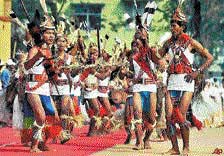
Firkal is an unusual name for a dance form. Many scholars of Indian dance as well as social anthropologists have not heard of it, far less seen it being performed. […]
Older than Kalaripayattu, and even those martial art forms that trace its origins to China and Japan, Firkal is still very much a living martial art-based dance form, performed mainly by the Bhumij tribes of Chotanagpur area in Jharkhand.
The distressing part is that Firkal survives in just one obscure village, Janumdih, located at Potka block in East Singhbhum district of Jharkand. Only 25 Bhumij families residing in this village are familiar with this art, and are seemingly unaware of the fact that this tradition may die out soon, if no one steps up to carry it forward.
“This is literally the last frontier of Firkal. Even the tribals do not feel the need to perform anymore,” says Amitabh Ghosh of The Celluloid Chapter Art Foundation (TCCAF), a social service organisation in Jamshedpur, engaged in the revival and promotion of the dance.
Raghunath Sardar of Veer Adim Kherwar Samiti (VAKS), a group working with the tribals in Janumdih adds, “Till 16 years ago, Firkal used to be performed almost everyday. But now, even in the only village it survives, we are able to hold performances only five to six times a year.” […]
Economic deprivation, degradation of land and the temptations of urban culture have led to large scale migration of tribals to greener pastures. The ones who are left behind have far more pressing problems to attend to, than that of the survival of a dance form that hardly anyone understands or appreciates.
Once in a while, the State Government holds Adivasi Utsavs in Jamshedpur where representatives of the Bhumij families are made to perform with other tribal dancers in the region, mainly as tourist attractions. It is a half-hearted, lackadaisical exercise that offers no incentive or dignity to dancers.
At first sight, Firkal appears to be like any other warrior dance performed by African tribes. However, no direct relationship has yet been established between these two ethnology streams. A closer link could be the Kirpan Susun or ‘sword dance’ practiced by aboriginal settlers in central India. […]
“Over time, the dance movements have changed into a leisurely, recreational exercise rather than a ritualistic demonstration of courage. These dance steps are variously known as Bagh Taal , Birsa Munda Taal and Pahalbani Taal. The younger generation, however, seem to be unfamiliar with these dance steps,” says Sardar. […]
Ghosh was first exposed to Firkal in a state-sponsored tribal fair at Jamshedpur in 1989. Enchanted by the natural vigour and sense of rhythm of the Bhumjis, he promptly rounded up a few friends to work with VAKS for the revival of this ancient art form. […]
These volunteers have already created an impressive library comprising old Firkal song recordings, video tapes analysing basic body movements, interviews with artistes and detailed studies on various rhythms and beats. The Association for Indian Development in Minnesota, USA recently extended a handsome grant towards this project.
Source: “The disappearing steps of tribal dance”, The Deccan Herald, 22 October 2011
Address : https://www.deccanherald.com/content/199806/disappearing-steps-tribal-dance.html
Date Visited: 23 March 2020
[Bold typeface added above for emphasis]
Indian tribal cultural heritage: museum collections, eBooks, maps & more
Anthropological Survey | Anthropology
Books on tribal culture and related resources
Crafts and visual arts | Homes and utensils Crafts and visual arts | Masks
Cultural heritage | Revival of traditions
Dress and ornaments | Fashion | Tattoo
eBook | Background guide for education
eBook | Free catalogue: Banam: One of the ancient musical instruments of the Santals – West Bengal
eBook | Free catalogue: Museum of Santal Culture (Bishnubati) – West Bengal
Games and leisure time | Martial arts
India’s 28 States and 8 Union Territories – From Andhra Pradesh to West Bengal
Tribal customs, homes and ornaments in South India: Videos and photographs by Vicky Lakshmanan